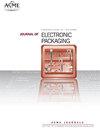利用多帧超分辨率红外热像仪和数字图像相关技术同时测量电子封装中的温度和应变
IF 2.3
4区 工程技术
Q3 ENGINEERING, ELECTRICAL & ELECTRONIC
引用次数: 1
摘要
对于微电子元件和系统来说,在热机械应力下的可靠性至关重要,并且依赖于表面热点和温度梯度的精确映射。一种非侵入性获取这些数据的方法是通过红外(IR)热成像。然而,IR热成像通常受到这种相机的典型低分辨率的限制。此外,使用数字图像相关(DIC)推断物理变形所需的表面光洁度准备工作干扰了使用红外热成像测量温度的能力,而红外热成像更喜欢均匀的高发射率。这项工作介绍了一种使用多帧超分辨率增强红外成像和数字图像相关(DIC)分析同时测量表面温度和变形的一次性技术。多帧超分辨率处理使用多个子像素移位的图像来提取单个更高分辨率的图像。物理变形的测量是使用具有黑色背景和低发射率散斑特征的测试样品进行的。通过处理和滤波,将用于表面温度映射的黑色表面区域的数据与用于使用DIC跟踪变形的散斑特征分离。该方法允许对IR图像执行DIC,从而产生与所施加的张力一致的变形场。虽然低分辨率和超分辨率数据集都可以用DIC成功处理,但超分辨率有助于减少提取的变形场中的噪声。至于温度测量,使用超分辨率可以更好地去除散斑特征,这可以通过与空间移动平均值的较低平均偏差来量化。本文章由计算机程序翻译,如有差异,请以英文原文为准。
Simultaneous Measurement of Temperature and Strain in Electronic Packages Using Multiframe Super-Resolution Infrared Thermography and Digital Image Correlation
For microelectronic components and systems, reliability under thermomechanical stress is of critical importance and relies on accurate mapping of surface hotspots and temperature gradients. One method of non-invasively acquiring this data is through infrared (IR) thermography. However, IR thermography is often limited by the typically low resolution of such cameras. Additionally, the surface finish preparations required to infer physical deformation using digital image correlation (DIC) interferes with the ability to measure the temperature with IR thermography, which prefers a uniform high emissivity. This work introduces a one-shot technique for the simultaneous measurement of surface temperature and deformation using multiframe super-resolution-enhanced IR imaging combined with digital image correlation (DIC) analysis. Multiframe super-resolution processing uses several sub-pixel shifted images to extract a single higher-resolution image. Measurement of physical deformation is incorporated using a test sample with a black background and low-emissivity speckle features. Through processing and filtering, data from the black surface regions used for surface temperature mapping are separated from the speckle features used to track deformation with DIC. This method allows DIC to be performed on the IR images, yielding a deformation field consistent with applied tensioning. While both the low- and super-resolution data sets can be successfully processed with DIC, super-resolution helps reduce noise in the extracted deformation fields. As for temperature measurement, using super-resolution is shown to allow for better removal of the speckle features, as quantified by a lower mean deviation from the spatial moving average.
求助全文
通过发布文献求助,成功后即可免费获取论文全文。
去求助
来源期刊

Journal of Electronic Packaging
工程技术-工程:电子与电气
CiteScore
4.90
自引率
6.20%
发文量
44
审稿时长
3 months
期刊介绍:
The Journal of Electronic Packaging publishes papers that use experimental and theoretical (analytical and computer-aided) methods, approaches, and techniques to address and solve various mechanical, materials, and reliability problems encountered in the analysis, design, manufacturing, testing, and operation of electronic and photonics components, devices, and systems.
Scope: Microsystems packaging; Systems integration; Flexible electronics; Materials with nano structures and in general small scale systems.
 求助内容:
求助内容: 应助结果提醒方式:
应助结果提醒方式:


